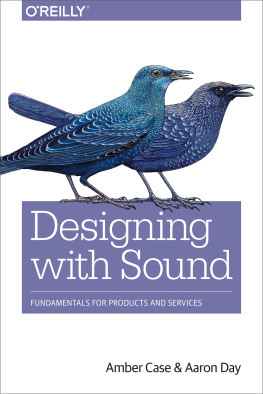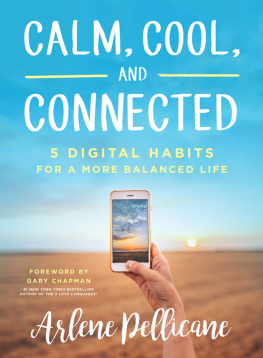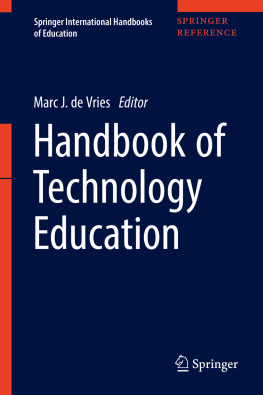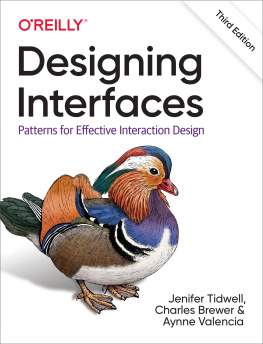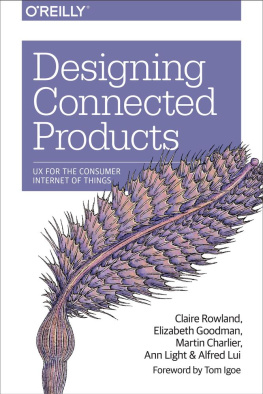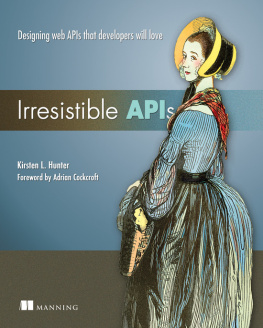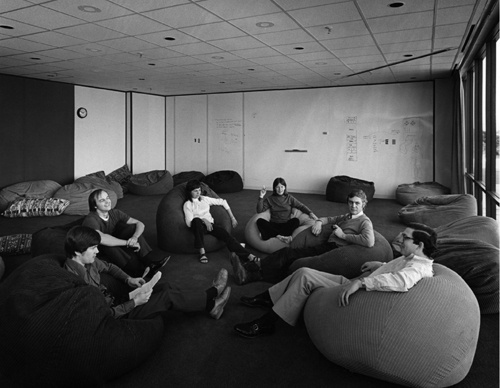Calm Technology: Principles and Patterns for Non-Intrusive Design
Amber Case
Beijing Boston Farnham Sebastopol Tokyo
Special Upgrade Offer
If you purchased this ebook directly from oreilly.com, you have the following benefits:
DRM-free ebooksuse your ebooks across devices without restrictions or limitations
Multiple formatsuse on your laptop, tablet, or phone
Lifetime access, with free updates
Dropbox syncingyour files, anywhere
If you purchased this ebook from another retailer, you can upgrade your ebook to take advantage of all these benefits for just $4.99. to access your ebook upgrade.
Please note that upgrade offers are not available from sample content.
Praise
In an ever-more complex world of gadgets, sensors, alerts, notifications, vibrations, data and digital interfaces society risks becoming overwhelmed with a myriad of options worthy, or not, of our attention. Designers and technologists need to consider how each decision they make about their product or service affects not only the immediate user but their ecosystem as a whole. This book makes that evidently clear and then points out how to be a more deliberate, considerate maker in the 21st century.
JEFF GOTHELF, AUTHOR, LEAN UX
Deceptively simple and straightforward, the book draws a comprehensive picture that connects the seminal work of 1990s Calm Technology pioneers Weiser and Brown to the design problems of the upcoming Internet of Things and of a world of constant human-information interactions. As generous with practical advice as it is with its theoretical foundations, Calm Technology offers a critical, user-centered reassessment of the interplay between design and technology in the age of pervasive and ubiquitous computing. Not a book that youll leave on your bookshelf often.
ANDREA RESMINI, SENIOR LECTURER, JNKPING UNIVERSITY
At last, a set of design principles concerned more with supporting human beings than business plans. Imagine a world where technology doesnt interrupt, cajole, and agitate, but rather creates time and space for people to reflect, engage, and even breathe. Amber Case not only envisions such a reality, but has shared the way we get there.
DOUGLAS RUSHKOFF, AUTHOR, PRESENT SHOCK & THROWING ROCKS AT THE GOOGLE BUS
In Calm Technology, Amber gives us ready to use patterns for designing calm interactions, as well as the underlying principles behind them. Anyone who builds things with a computer in it (which is everything) should read this book.
JOSH MARINACCI, TECHNICAL MARKETING MANAGER, PUBNUB
In an era where we are surrounded by always-on devices, blinking, beeping, vibrating, and jostling for our attention, Amber Cases tightly focused monograph on the tenets of calm design comes at just the right time. As we rely more and more on our technology for ordinary daily life, designers, product managers, and entrepreneurs will do well to pay close attention on how our designs are affecting the mood and well being of our customers, and to learn how to design experiences that calm and soothe, instead of agitating and upsetting.
CHRISTIAN CRUMLISH, VP PRODUCT, 7CUPS.COM & COAUTHOR, DESIGNING SOCIAL INTERFACES , SECOND EDITION
I loved this book. Too often our product discussions are technology- led, but this book builds from the human out, starting off with insightful guidelines, moving into specific design patterns, and even having exercises to bring the points home. This book creates a new vocabulary we will be using in future product design.
SCOTT JENSON, PRODUCT STRATEGY, GOOGLE
Preface
I FIRST CAME ACROSS Mark Weiser and John Seely Browns work Designing Calm Technology in 2005. I was a sophomore in college at the time, and although technology was a passion of mine, my coursework and research were primarily in anthropologyI didnt yet know how tightly linked the two disciplines actually were. I was just beginning to discover how important an understanding of human behavior was to the design of technology, and specifically, the ways we communicate with our devices.
In 2005, smartphones were just entering the landscape, transforming the humble mobile phone from a glorified walkie-talkie into a fully functioning computer that would take all of the challenges of computer user interfaces and amplify them in our daily lives. It was this research that led me to eventually write my thesis on smartphones and their impact on human culture. During my research I stumbled upon a little-known but breakthrough paper in humancomputer interaction from the mid-90s called Designing Calm Technology. It turned out that researchers at Xerox PARC, including technologists and anthropologists from a variety of backgrounds, had been working for years on understanding the impact of technology on peoples behavior and well-being.
Their chief concern was how to best design technologies for a future saturated with small devices. I realized that the subject of Calm Technology and the research underlying it were not just about where the Internet was headed, but where our entire society was headed. The topic was worth a lot more attention that it had originally received.
Figure P-1. Xerox PARC Computer Science Laboratory (CSL), circa 1980s, where early Internet pioneer and Lab Director Bob Taylor held informal meetings with laboratory students in beanbag chairs.[]
Weiser and Brown were at least a decade ahead of their time. They were so far ahead that their work is in danger of being forgotten...precisely at the time we most need it. Weiser was the intellectual father of Ubiquitous Computing. He and Brown first introduced the concept of Calm Technology in their 1995 paper, published at Xerox PARC. This is still the term most commonly used to describe it, though it might be more accurate to call it Calm Interaction, or simply Calm Design.
We need their conceptual framework, their advice, and their research now more than ever, or we will increasingly run into issues like loss of human agency, security, and privacy, not to mention a crisis of bandwidth. None of us wants a future where we continuously update settings for apps we never use, nor do we want to always be on pause while waiting for a bit of technology to fix itself. Weiser said that we wouldnt be able to interact with future technology the same way that we interact with a desktop computer. That future is now.
In 2005 we were just beginning to see the promise of mobile devices, but back in the 80s and 90s, Weiser and Brown envisioned a future full of devices much like our current televisions, smartphones, and tablets: a series of what they called pads, tabs, and boards. As time progressed, I realized just how core their insights would be in a world increasingly mediated by technology.
My study of cell phones, social cues, and interface design quickly grew into a career in user experience (UX) and interaction design. I eventually realized that most technology gets in the way of peoples lives instead of working with them. Were stuck with heavy applications struggling to work on connected smartphones with minimal battery life. How will a coming era of small devices solve this problem? Were poised to become even more anxious and overwhelmed, with everything beeping at us.


